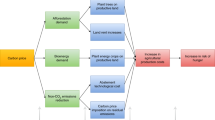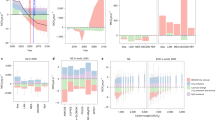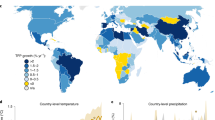Abstract
Agricultural practices that enhance soil carbon are increasingly being included in domestic climate strategies. The potential for these practices to affect productivity means that associated changes in land use can substantially alter net climate effects. Here we combine estimates of links between total factor productivity (TFP) and cropland use in each country with estimates of carbon emissions for cropland expansion to define TFP–emission links for each country pair. We then calculate the impact of TFP changes on both domestic and global emissions. In a scenario whereby practices reduce TFP by 5%, consistent with recent findings for cover cropping, we show that the net climate benefits of these practices are reduced in most countries—and by 70% in the United States and 80% in Europe. We also find stark contrasts between domestic and global climate impacts of TFP changes, highlighting the pitfalls of basing climate policy solely on domestic emissions targets.
This is a preview of subscription content, access via your institution
Access options
Access Nature and 54 other Nature Portfolio journals
Get Nature+, our best-value online-access subscription
$29.99 / 30 days
cancel any time
Subscribe to this journal
Receive 12 digital issues and online access to articles
$119.00 per year
only $9.92 per issue
Buy this article
- Purchase on Springer Link
- Instant access to full article PDF
Prices may be subject to local taxes which are calculated during checkout




Similar content being viewed by others
Data availability
The data and code used in this study are available as an R package ‘TFPtoCO2’ at https://github.com/nvilloria/TFPtoCO2.
Code availability
Codes to replicate figures are available at https://doi.org/10.5281/zenodo.7782534.
References
Falkner, R. The Paris Agreement and the new logic of international climate politics. Int. Aff. 92, 1107–1125 (2016).
Poore, J. & Nemecek, T. Reducing food’s environmental impacts through producers and consumers. Science 360, 987–992 (2018).
Crippa, M. et al. Food systems are responsible for a third of global anthropogenic GHG emissions. Nat. Food 2, 198–209 (2021).
Griscom, B. W. et al. Natural climate solutions. Proc. Natl Acad. Sci. USA 114, 11645–11650 (2017).
Roe, S. et al. Land-based measures to mitigate climate change: potential and feasibility by country. Glob. Chang. Biol. 27, 6025–6058 (2021).
Branger, F. & Quirion, P. Would border carbon adjustments prevent carbon leakage and heavy industry competitiveness losses? Insights from a meta-analysis of recent economic studies. Ecol. Econ. 99, 29–39 (2014).
Hertel, T. W. Economic perspectives on land use change and leakage. Environ. Res. Lett. https://doi.org/10.1088/1748-9326/aad2a4 (2018).
Kim, M. K., Peralta, D. & McCarl, B. A. Land-based greenhouse gas emission offset and leakage discounting. Ecol. Econ. 105, 265–273 (2014).
Fargione, J., Hill, J., Tilman, D., Polasky, S. & Hawthorne, P. Land clearing and the biofuel carbon debt. Science 319, 1235–1238 (2008).
Villoria, N. B. Technology spillovers and land use change: empirical evidence from global agriculture. Am. J. Agric. Econ. 101, 870–893 (2019).
Renewable Fuel Standard Program (RFS2) Regulatory Impact Analysis: February 2010 (US EPA, 2010).
Detailed Analysis for Indirect Land Use Change (CARB, 2015).
Pittelkow, C. M. et al. Productivity limits and potentials of the principles of conservation agriculture. Nature https://doi.org/10.1038/nature13809 (2014).
Rusinamhodzi, L. et al. A meta-analysis of long-term effects of conservation agriculture on maize grain yield under rain-fed conditions. Agron. Sustain. Dev. 31, 657–673 (2011).
Jeffery, S. et al. Biochar boosts tropical but not temperate crop yields. Environ. Res. Lett. 12, 053001 (2017).
Ye, L. et al. Biochar effects on crop yields with and without fertilizer: a meta-analysis of field studies using separate controls. Soil Use Manage. 36, 2–18 (2020).
Wallander, S., Smith, D., Bowman, M. & Claassen, R. Cover Crop Trends, Programs, and Practices in the United States (USDA Economic Research Service, 2021).
Griscom, B. W. et al. National mitigation potential from natural climate solutions in the tropics. Phil. Trans. R. Soc. B 375, 20190126 (2020).
Schlesinger, W. H. Biogeochemical constraints on climate change mitigation through regenerative farming. Biogeochemistry 161, 9–17 (2022).
Powlson, D. S., Poulton, P. R., Glendining, M. J., Macdonald, A. J. & Goulding, K. W. T. Is it possible to attain the same soil organic matter content in arable agricultural soils as under natural vegetation? Outlook Agric. 51, 91–104 (2022).
Corbeels, M. et al. Evidence of limited carbon sequestration in soils under no-tillage systems in the Cerrado of Brazil. Sci. Rep. 6, 21450 (2016).
Corbeels, M., Naudin, K., Whitbread, A. M., Kühne, R. & Letourmy, P. Limits of conservation agriculture to overcome low crop yields in sub-Saharan Africa. Nat. Food 1, 447–454 (2020).
Mills, G. et al. Ozone pollution will compromise efforts to increase global wheat production. Glob. Chang. Biol. 24, 3560–3574 (2018).
Lobell, D. B., Di Tommaso, S. & Burney, J. A. Globally ubiquitous negative effects of nitrogen dioxide on crop growth. Sci. Adv. 8, 9909 (2022).
Hertel, T. W. et al. Effects of US maize ethanol on global land use and greenhouse gas emissions: estimating market-mediated responses. Bioscience 60, 223–231 (2010).
Golub, A. A. et al. Global climate policy impacts on livestock, land use, livelihoods, and food security. Proc. Natl Acad. Sci. USA 110, 20894–20899 (2013).
Baldos, U. & Hertel, T. W. SIMPLE: a Simplified International Model of agricultural Prices, Land use and the Environment. (Center for Global Trade Analysis, Department of Agricultural Economics, Purdue University, 2012).
Fabiosa, J. F. et al. Land allocation effects of the global ethanol surge: predictions from the international FAPRI model. Land Econ. 86, 687–706 (2010).
FAO Statistical Databases (FAO, 2021); https://www.fao.org/faostat/en
Fuglie, K. O. in Productivity Growth in Agriculture: An International Perspective (ed. Fuglie, K. O.) 335–368 (USDA Economic Research Service, 2012).
Fuglie, K. R&D capital, R&D spillovers, and productivity growth in world agriculture. Appl. Econ. Perspect. Policy 40, 421–444 (2018).
Colin Cameron, A., Gelbach, J. B. & Miller, D. L. Bootstrap-based improvements for inference with clustered errors. Rev. Econ. Stat. 90, 414–427 (2008).
Esarey, J. & Menger, A. Practical and effective approaches to dealing with clustered data. Polit. Sci. Res. Methods 7, 541–559 (2019).
West, P. C. et al. Trading carbon for food: global comparison of carbon stocks vs. crop yields on agricultural land. Proc. Natl Acad. Sci. USA 107, 19645–19648 (2010).
Hong, C. et al. Global and regional drivers of land-use emissions in 1961–2017. Nature 589, 554–561 (2021).
Hansis, E., Davis, S. J. & Pongratz, J. Relevance of methodological choices for accounting of land use change carbon fluxes. Global Biogeochem. Cycles 29, 1230–1246 (2015).
Potapov, P. et al. Global maps of cropland extent and change show accelerated cropland expansion in the twenty-first century. Nat. Food 3, 19–28 (2022).
Lark, T. J., Mueller, R. M., Johnson, D. M. & Gibbs, H. K. Measuring land-use and land-cover change using the U.S. Department of Agriculture’s cropland data layer: cautions and recommendations. Int. J. Appl. Earth Obs. Geoinf. 62, 224–235 (2017).
Abdalla, M. et al. A critical review of the impacts of cover crops on nitrogen leaching, net greenhouse gas balance and crop productivity. Glob. Chang. Biol. 25, 2530–2543 (2019).
Basche, A. D. et al. Soil water improvements with the long-term use of a winter rye cover crop. Agric. Water Manag. 172, 40–50 (2016).
Deines, J. M., Wang, S. & Lobell, D. B. Satellites reveal a small positive yield effect from conservation tillage across the US corn belt. Environ. Res. Lett. 14, 124038 (2019).
Rosa, A. T. et al. Implications of cover crop planting and termination timing on rainfed maize production in semi-arid cropping systems. Field Crops Res. 271, 108251 (2021).
Malone, L. C. et al. Cover crops in a Wisconsin annual cropping system: feasibility and yield effects. Agron. J. 114, 1052–1067 (2022).
Qin, Z. et al. Assessing the impacts of cover crops on maize and soybean yield in the U.S. Midwestern agroecosystems. Field Crops Res. 273, 108264 (2021).
Deines, J. M. et al. Recent cover crop adoption is associated with small maize and soybean yield losses in the United States. Glob. Chang. Biol. 29, 794–807 (2022).
Marcillo, G. S. & Miguez, F. E. Corn yield response to winter cover crops: an updated meta-analysis. J. Soil Water Conserv. 72, 226–239 (2017).
Alvarez, R., Steinbach, H. S. & De Paepe, J. L. Cover crop effects on soils and subsequent crops in the pampas: a meta-analysis. Soil Tillage Res. 170, 53–65 (2017).
Acknowledgements
We thank C. Hong for providing country-level committed land-use emissions estimates and T. Hertel for helpful discussions. N.B.V. acknowledges funding from US Department of Agriculture, National Institute of Food and Agriculture, Multistate Research Project S1072.
Author information
Authors and Affiliations
Contributions
D.B.L. conceived the study; D.B.L. and N.B.V. analysed data and wrote the paper; N.B.V. created R package ‘TFPtoCO2’ to accompany the paper.
Corresponding author
Ethics declarations
Competing interests
The authors declare no competing interests.
Peer review
Peer review information
Nature Sustainability thanks William H Schlesinger and the other, anonymous, reviewers for their contribution to the peer review of this work.
Additional information
Publisher’s note Springer Nature remains neutral with regard to jurisdictional claims in published maps and institutional affiliations.
Supplementary information
Supplementary Table
Multiple sheets including supplemental tables and a readme file.
Rights and permissions
Springer Nature or its licensor (e.g. a society or other partner) holds exclusive rights to this article under a publishing agreement with the author(s) or other rightsholder(s); author self-archiving of the accepted manuscript version of this article is solely governed by the terms of such publishing agreement and applicable law.
About this article
Cite this article
Lobell, D.B., Villoria, N.B. Reduced benefits of climate-smart agricultural policies from land-use spillovers. Nat Sustain 6, 941–948 (2023). https://doi.org/10.1038/s41893-023-01112-w
Received:
Accepted:
Published:
Issue Date:
DOI: https://doi.org/10.1038/s41893-023-01112-w
This article is cited by
-
Addressing ‘leaks’ in climate-smart agriculture
Nature Sustainability (2023)



